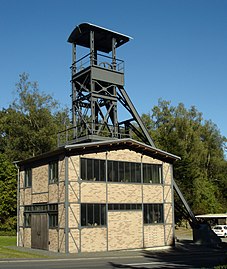Grimberg mine
| Grimberg | |||
|---|---|---|---|
| General information about the mine | |||
| A winding tower as a memorial | |||
| Funding / total | 827,307 t of iron ore | ||
| Rare minerals | Barite , millerite , ullmannite | ||
| Information about the mining company | |||
| Employees | 160 | ||
| Start of operation | 1794 | ||
| End of operation | 1910 | ||
| Funded raw materials | |||
| Degradation of | Iron ore | ||
| Greatest depth | 782 m | ||
| Geographical location | |||
| Coordinates | 50 ° 51 '32.1 " N , 8 ° 4' 18.2" E | ||
|
|||
| Location | Grimberg | ||
| local community | Wilnsdorf | ||
| District ( NUTS3 ) | Siegen-Wittgenstein | ||
| country | State of North Rhine-Westphalia | ||
| Country | Germany | ||
| District | Bergrevier Siegen II | ||
The Grimberg mine in Niederdielfen was one of the most important ore mines in the area of the municipality of Wilnsdorf in North Rhine-Westphalia . It was on the Grimberg between Dielfen and Siegen .
Aisle means
The passage means the mine belonged to Grimberger lode . The passage filling consisted largely of iron ore. The mean copper rose was 100 m long and 0.5–3 m thick. The Goeben corridor was up to 348 m long, 2 m, sometimes up to 6 m thick and, like the Werder corridor, was interspersed with sturdy zinc blanks. The middle Einsiedel had a length of 130 m, of which 50 m could be mined and a thickness of 0.3–1 m. Here the ore was found together with lead and zinc. In addition, there were the less large gang means Junge Grimberg and Alter Grimberg . Were reduced in Grimberger lode iron , - Lead - copper - and zinc ores .
history
|
Around 1520 there was a Rödgerwald mine nearby . The boy Grimberg was first mentioned in the 1750s .
Miner Johann Henrich Knipp (born August 24, 1767 in Niederdielfen, † September 20, 1791 in the old mine at Grimberg) and also miner Johann Peter Michel from Geismar-Hessen, only three weeks at Grimberg mine, was on December 27, 1792 at the age of Had a fatal accident there due to sudden water ingress there for 27 years, so that the mine was closed for a long time due to the investigation. In the records of the Evangelical Book of the Dead of the parish of Rödgen it is documented that ores were mined here at that time. The mining area was re-awarded in 1860. In 1865 the Julianschacht was built . This reached a depth of 782 m, the ore was mined on 14 levels . In 1866 it was already 63 m deep, a year later it was 84 m and in 1885 130 m. Its headframe was demolished in 1911. The Goebenschacht was built 200 m from the shaft . In 1891, compressed air mining was introduced. The annual production up to 1899 was up to 32,450 t of iron ore. On May 28, 1902, the mine consolidated with the Eisenzeche , Tubalkain , Vollbracht and Marienborn pits . The local government confirmed this on October 9th.
In 1910 the mine was closed. Up to 170 miners worked there, but the average was 160. The total production from 1867–1910 was 827,307 t of iron ore. Production was still around 4,200 t in 1868 and rose to 10,400 t of Spateisenstein by 1885. By 1899 this rate rose to 32,450 t and then fell again. By April 1, 1914, all of the mine’s surface facilities were demolished.
The Grimberg mine was one of the most famous sites for very well-formed galena crystals .
monument
In the 1970s the shaft was closed with a concrete slab. In 1995 a 16 m high winding tower from Bensberg ( Bergisch Gladbach ) with a shaft building was erected as a memorial above it . It stands directly on the connecting road between Niederdielfen and Siegen or Obersdorf .
See also
literature
- S. Hucko, M. Reinhardt: Mining on the Grimberg in Niederdielfen , 2009
- Ute Bosbach: Searching for traces in Eisenland - On the way on ore roads and miners ' paths, amadeusmedien, November 2006. ISBN 3-9808936-8-5
Individual evidence
- ^ Grimberg pit sign
- ↑ a b c T. Hundt, G. Gerlach, F. Roth, W. Schmidt: Description of the mountain areas Siegen I, Siegen II, Burbach & Müsen ; Bonn 1887
- ^ Journal for the mining, smelting and salt works in the Prussian state , Berlin; Edition 1869
- ↑ Hans Dietrich Gleichmann: Die Eiserne Hardt - From the mining of the Siegerland. Bertelsmann Fachzeitschriften Verlag, Gütersloh 1987.
- ^ FM Simmersbach: History of mining in the Siegerland region, Bochum / Berlin 1881 (PDF; 243 kB)
- ^ Journal for the mining, smelting and salt works in the Prussian state , Berlin; Edition 1895
- ^ Hans Dietrich Gleichmann: Der Füssenberg - The great time of the Siegerland iron ore mining , Bertelsmann Fachzeitschriften-Verlag Gütersloh, 1994.
- ^ Association for mining in Siegerland, special exhibition at the mining and mineral exchange 2011 in Wilnsdorf
- ^ Journal for the mining, smelting and salt works in the Prussian state , Berlin; Edition 1867
- ^ Journal for the mining, smelting and salt works in the Prussian state , Berlin; Edition 1868
- ↑ "Grimberg Pit"
- ↑ "Galenit" , Mineralienatlas, July 14, 2007
Web links
- Gerd Bäumer: Ore mining in the Siegerland area ( Memento from November 7, 2001 in the Internet Archive )
- The pit with pictures and information on the Niederdielfen website
- ( Page no longer available , search in web archives: opening of the winding tower )
- Niederdielfen winding tower on the Wilnsdorf museum side

